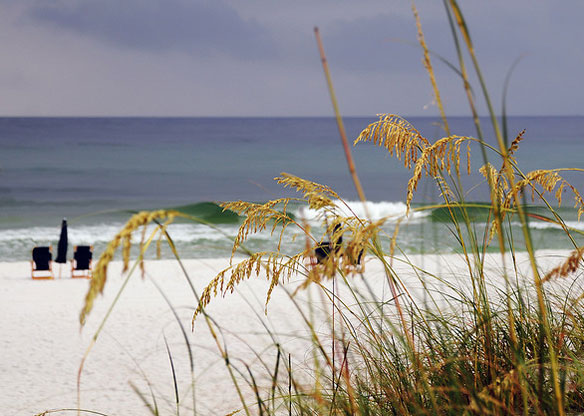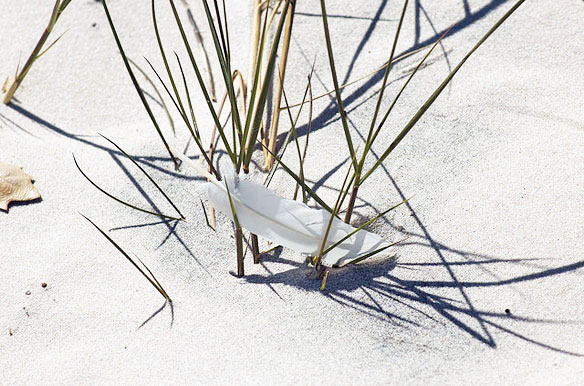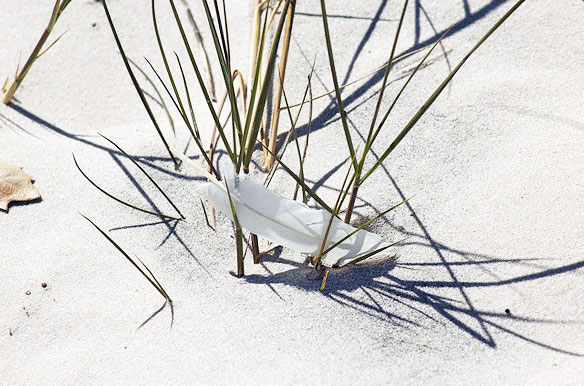
White sand beach, Okaloosa County, Florida. Photo source: ©© faungg
By Robert S. Young, PhD, Director Program for the Study of Developed Shorelines
Florida led the nation in establishing detailed criteria for ensuring that only high-quality sand is placed on Florida beaches during construction of beach nourishment projects.
While the Sand Rule (Florida Administrative Code 62B-41.007j) explicitly indicates that the goal is to “protect the environmental functions of Florida’s beaches,” it has also served to protect the economic interests of coastal communities dependent upon the high quality and aesthetic beauty of those beaches.
Using Florida as an example, North Carolina established similar, but more stringent, criteria for beach nourishment projects on our valuable beaches.
Now it seems the Florida Department of Environmental Protection (FDEP) would like to weaken these sand quality standards or even bypass them altogether. Why would a state that places such a high value on the quality of its beaches do this? It might have something to do with two recent instances in which administrative law judges have recommended that permits for beach nourishment projects be rescinded due to sand-quality issues and violations of the Sand Rule.
The most recent case involves a proposed beach nourishment project for Okaloosa Island.
The tourism website for the Emerald Coast describes the beaches like this: “Florida’s Emerald Coast offers 24 miles of pristine white-sand beaches. … This sand, made up of pure Appalachian quartz, remains remarkably cool even in the heat of summer, and gives the waters here their trademark emerald-green color by reflecting sunlight back up through the surf.”
I agree.
I bring my two young boys to visit these beaches because they have the highest quality and most stunningly beautiful sand I have ever seen. And, through my job, I have visited many beaches all over the world.

Okaloosa island, Florida. Photo source: ©© Scott
Okaloosa County applied for, and was granted, a permit to pump sand onto 2.8 miles of pure “sugar sand” beach on Okaloosa Island. We know exactly what this “fill sand” will look like, because a nearby beach was covered with this exact same material. The sand is not of Emerald Coast quality. It is far darker, has large shell shards throughout, and is not composed of the pure Appalachian quartz sand advertised by local tourism officials.
It will completely change the Okaloosa Island beach.
Many property owners on Okaloosa Island expressed grave concerns over the project and how it will impact their community. The entire Northwest Florida legislative delegation is so concerned that it passed a resolution urging abandonment of the project out of concern for the economic impacts that will come from “exposing visitors to a downgraded beach-going experience.”
Ultimately, Okaloosa property owners filed suit, arguing the project would degrade their beach. In September, an administrative law judge agreed and issued a recommended order indicating the permit should be rescinded because the sand is clearly not beach compatible. He held that the proposed fill violates the Sand Rule in that it does not “maintain the general character and functionality of the material occurring on the beach and in the adjacent dune and coastal system,” as the Rule stipulates. He recognized the fill material would completely change the character of that beach because it is darker and shell-laden.
I have a dog in this hunt. I served as an expert witness for the plaintiffs. Yet, all of those who relish the high quality and beauty of Florida beaches celebrated this ruling. Sadly, the celebration was short-lived. On Dec. 29, the secretary of FDEP overruled the judge and ordered the permit be issued. In doing so he ignored the Sand Rule’s unequivocal requirement that beach not contain material coarser than the native beach and ignored the spirit of the rule requiring fill material maintain the “general character” of the native beach (color, shell content).
In my opinion, he gave license to Okaloosa County to kill the goose that laid the golden egg — the “sugar sand” beach. One wonders why the county would want to do this?
The beach on Okaloosa Island is already wide, with a formidable dune in most locations. There is a lot of money to be made selling beach nourishment projects, and some folks seem to think that if you have a chance to pump some sand, well, you just ought to.
Some have argued that FDEP is simply trying to streamline burdensome regulations; but, this is very short-sighted. The quality of Florida beaches matters.
The Sand Rule must be preserved and enforced to protect the coastal economy and the environment. It is a rare two-fer, and a no brainer.

Photo source: ©© Davew Wilson









